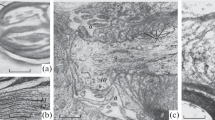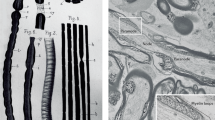Summary
Observations are reported on the ultrastructural alterations at the nodes of Ranvier in the rat sural nerve during the course of Wallerian degeneration. These were examined between 12 and 120 hours after a localized crush injury.
The earliest detectable changes are in the axon. Nodal and paranodal accumulations of mitochondria, multivesicular bodies, lamellar bodies and small vesicular and tubular profiles are seen at a proportion of the nodes and are most evident at 24–36 hours. Concomitantly with this, the neurofilaments and neurotubulus fragment, lose their alignment and clump together. The zone of increased density just beneath the nodal axolemma is preserved.
Changes in the myelin begin slightly later and consist of vesicular breakdown of the terminal myelin lamellae, and separation of the terminal myelin loops from the axolemma by Schwann cell processes. The latter event appeared to be associated with retraction of the myelin from the node. Schwann cell processes also extend to cover the nodal axon, separating the Schwann cell nodal processes from the axolemma.
The final stage is the interruption of the nodal axon and the fusion of the ends of the myelin as part of ovoid formation.
Zusammenfassung
Es wird über ultrastrukturelle Veränderungen in den Ranvierschen Knoten des N.suralis der Ratte im Laufe der Wallerschen Degeneration berichtet. Die Untersuchungen erfolgten 12 und 120 Std nach einer örtlichen Quetschungsverletzung.
Die ersten bemerkbaren Veränderungen finden sich im Axon. Nodale und paranodale Anhäufungen von Mitochondrien, multivesikulären und lamellären Körpern, wie auch kleinen blasen- und röhrenartigen Bildungen sind teilweise in den Knoten sichtbar und am deutlichsten nach 24–36 Std erkennbar. Gleichzeitig erfolgt eine Aufsplitterung der Neurofilamente und Neurotubuli, die ihre Liniengestaltung verlieren und sich zusammenballen. Die Zone der erhöhten Dichte gerade unterhalb des nodalen Axolemmas bleibt erhalten.
Veränderungen im Myelin beginnen etwas später und bestehen in einem vesikulären Verfall der Endomyelinlamellen und einer Trennung der Endomyelinschlaufen vom Axolemma durch Schwannzellenfortsätze. Dieser Vorgang schien mit einem Zurückziehen des Myelins vom Knoten im Zusammenhang zu stehen. Schwannzellenfortsätze erstrecken sich auch so weit, daß sie das nodale Axon bedecken, wobei sie die nodalen Schwannzellenfortsätze vom Axolemma trennen.
Das Endstadium ist die Unterbrechung des nodalen Axons und die Verschmelzung der Myelinenden als Teil der Ovoidbildung.
Similar content being viewed by others
References
Allt, G.: An experimental study of ultrastructural relationships at the node of Ranvier. M. Phil. thesis, University of London 1968.
Andres, K. H.: Über die Feinstruktur besonderer Einrichtungen in markhaltigen Nervenfasern des Kleinhirns der Ratte. Z. Zellforsch.65, 701–712 (1965).
Ballin, R. H. M., Thomas, P. K.: Electron microscope observations on demyelination and remyelination in experimental allergic neuritis. I. Demyelination. J. Neurol. Sci.8, 1–18 (1968).
——: Electron-microscope observations on nodal changes during Wallerian degeneration. J. Anat. (Lond.)104, 184–185 (1969).
Cajal, S., Ramon Y.: Degeneration and regeneration of the nervous system. London: Oxford University Press 1928.
Causey, G., Palmer, E.: Early changes in degenerating mammalian nerves. Proc. roy. Soc. B139, 597–609 (1952).
——: The centrifugal spread of structural change at the nodes in degenerating mammalian nerves. J. Anat. (Lond.)87, 185–191 (1953).
Cavanagh, J. B., Jacobs, J. M.: Some quantitative aspects of diphtheritic neuropathy. Brit. J. exp. Path.45, 309–322 (1964).
Conradi, S.: Ultrastructural specialization of the initial axon segment of cat lumbar motoneurons. Acta Soc. Med. upsalien.71, 281–284 (1966).
Cragg, B. G., Thomas, P. K.: Changes in nerve conduction in experimental allergic neuritis. J. Neurol. Neurosurg. Psychiat.27, 106–115 (1964).
Denny-Brown, D., Brenner, C.: Paralysis of nerve induced by direct pressure and by tourniquet. Arch. Neurol. (Chic.)51, 1–26 (1944).
Elfvin, L.-G.: The ultrastructure of the nodes of Ranvier in cat sympathetic nerve fibers. J. Ultrastruct. Res.5, 374–387 (1961).
Hall, J. I.: Studies on demyelinated nerves in guinea-pigs with experimental allergic neuritis, Part 2 (electrophysiological observations). Brain90, 313–332 (1967).
Holtzman, E., Novikoff, A. B.: Lysosomes in the rat sciatic nerve following crush. J. Cell Biol.27, 651–669 (1965).
Landon, D. N., Williams, P. L.: Ultrastructure of the nodes on Ranvier. Nature (Lond.)199, 575–577 (1963).
Langley, O. K.: The use of metallic stains in histochemical studies on the node of Ranvier of the peripheral nerve fibre. Proc. roy. micr. Soc.3, 90–91 (1968).
— Landon, D. N.: A light and electron histochemical approach to the node of Ranvier and myelin of peripheral nerve fibers. J. Histochem. Cytochem.15, 722–731 (1968).
McDonald, W. I.: The effects of experimental demyelination on conduction in peripheral nerve: a histological and electrophysiological study. II. Electrophysiological observations. Brain86, 501–524 (1963).
Palay, S. L., Sotelo, C., Peters, A., Orkand, P. M.: The axon hillock and the initial segment. J. Cell Biol.38, 193–201 (1968).
Peters, A.: The node of Ranvier in the central nervous system. Quart. J. exp. Physiol.51, 229–236 (1966).
Ranvier, L.: Leçons sur l'Histologie du Système Nerveux. Paris: Savy 1878.
Robertson, J. D.: Structural alterations in nerve fibers produced by hypotonic and hypertonic solutions. J. biophys. biochem. Cytol.4, 349–364 (1958).
Thomas, P. K.: Changes in the endoneurial sheaths of peripheral myelinated nerve fibres during Wallerian degeneration. J. Anat. (Lond.)98, 175–182 (1964).
Venable, J. H., Coggeshall, R.: A simplified lead citrate stain for use in electron microscopy. J. Cell Biol.25, 407–408 (1965).
Vial, J. D.: The early changes in the axoplasm during Wallerian degeneration. J. biophys. biochem. Cytol.4, 551–556 (1958).
Webster, H. de F.: Transient focal accumulation of axonal mitochondria during the early stages of Wallerian degeneration. J. Cell Biol.12, 361–384 (1962).
Williams, P. L., Landon, D. N.: Paranodal apparatus of peripheral myelinated nerve fibres of mammals. Nature (Lond.)198, 670–673 (1963).
Young, J. Z.: Surface tension and the degeneration of nerve fibres. Nature (Lond.)154, 521–522 (1944).
Author information
Authors and Affiliations
Rights and permissions
About this article
Cite this article
Ballin, R.H.M., Thomas, P.K. Changes at the nodes of ranvier during wallerian degeneration: an electron microscope study. Acta Neuropathol 14, 237–249 (1969). https://doi.org/10.1007/BF00685303
Received:
Issue Date:
DOI: https://doi.org/10.1007/BF00685303




